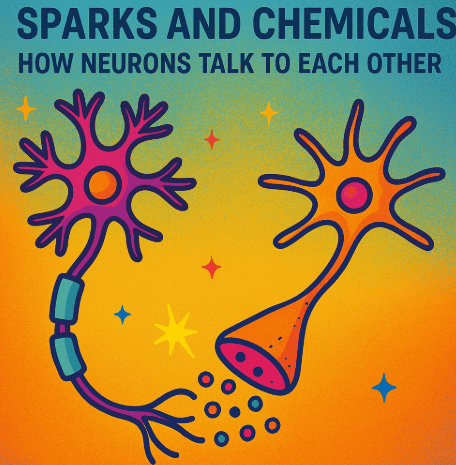
Recap of Lesson 2
In our last lesson, we met the stars of the brain:
-
Neurons → the messengers, sending and receiving signals.
-
Glia → the helpers, protectors, feeders, and speed boosters.
We saw that neurons connect through trillions of junctions called synapses, and these networks give rise to our thoughts, memories, and identity.
Now, the big question: How do these neurons actually “talk”? That’s what this lesson is about.
Section 1: The Spark of Life – Electricity in the Brain
Imagine you flip on a light switch 💡. Electricity flows through the wires, and the bulb glows.
In the brain, the same kind of thing happens — except instead of copper wires, we have neurons, and instead of a light bulb, we get thought, movement, or feeling.
But here’s the twist: neurons don’t use “normal” electricity. They use something special called an action potential.
What is an Action Potential?
An action potential is a quick electrical spark that travels down the axon of a neuron. It’s the way neurons send signals.
Think of it like a wave in a stadium 🏟️. One person stands up, then the next, then the next, creating a wave. No one person moves across the stadium — the wave moves. Similarly, in a neuron, charged particles move in and out of the cell, creating a traveling wave of electricity.
Section 2: How Does the Spark Start?
At rest, a neuron’s inside is a little negative compared to the outside. This difference is called the resting potential (about –70 millivolts).
-
The inside has more potassium (K⁺) ions.
-
The outside has more sodium (Na⁺) ions.
When a signal comes in (say, from another neuron), ion channels (tiny protein doors) open. Sodium rushes in, making the inside more positive.
If the signal is strong enough to cross a threshold (like a push strong enough to tip a domino), the neuron fires an action potential.
This is called the all-or-none rule:
-
If the spark reaches threshold → the neuron fires fully.
-
If it doesn’t → nothing happens.
Just like a gun: it either fires, or it doesn’t. There’s no half-firing. 🔫
Section 3: Riding the Axon – The Signal Travels
Once triggered, the action potential races down the axon.
-
Unmyelinated axons (no insulation) send signals slowly (~1 m/s).
-
Myelinated axons (insulated with fatty myelin) send signals much faster (~120 m/s).
The signal “jumps” between gaps in the myelin called nodes of Ranvier. This jumping is called saltatory conduction (from “saltare,” Latin for “to jump”).
It’s like a high-speed train 🚄 skipping small stations instead of stopping at every one.
Section 4: The Chemical Bridge – Synapses
But here comes a challenge: Neurons don’t touch each other. Between them is a tiny gap called the synaptic cleft (about 20–40 nanometers wide — much smaller than a speck of dust).
So how does the spark jump this gap?
Answer: chemicals called neurotransmitters.
When the action potential reaches the axon terminal:
-
Tiny bubbles (vesicles) filled with neurotransmitters fuse with the cell membrane.
-
The neurotransmitters spill into the synaptic cleft.
-
They bind to receptors on the next neuron.
-
This either excites (starts a new spark) or inhibits (stops a spark) the next neuron.
This process is like sending a message in a bottle across a river 🌊.
Section 5: The Brain’s Chemical Messengers
Different neurotransmitters create different effects:
-
Dopamine 🎮 → motivation, reward, learning, addiction.
-
Serotonin 🙂 → mood, sleep, appetite.
-
Acetylcholine 🎶 → movement, memory, attention.
-
Glutamate 🔥 → the main excitatory transmitter (starts sparks).
-
GABA 🛑 → the main inhibitory transmitter (calms activity).
-
Norepinephrine ⚡ → alertness, stress response.
-
Endorphins 🥰 → pain relief, pleasure, euphoria.
These chemicals shape everything from falling in love ❤️ to running from danger 🏃♂️ to solving math problems ✏️.
Section 6: Excitatory vs. Inhibitory Signals
Neurons are not just switches that turn “on.” They also have brakes.
-
Excitatory neurotransmitters (like glutamate) make the next neuron more likely to fire.
-
Inhibitory neurotransmitters (like GABA) make it less likely to fire.
The brain works by balancing gas and brakes. Too much gas → seizures. Too much brake → coma.
It’s a delicate dance.
Section 7: From Sparks and Chemicals to Thought
Now comes the big leap: how does all this lead to thought?
Imagine:
-
One neuron = one dot on a TV screen.
-
A network of billions = a moving movie 🎬.
Each thought, memory, or feeling is a pattern of neurons firing together.
-
Seeing a face → specific neurons in the visual cortex fire.
-
Remembering your birthday → neurons in the hippocampus fire.
-
Feeling fear → neurons in the amygdala fire.
The mind is not in one neuron, but in the orchestra 🎼 of billions firing in patterns.
Section 8: Why This Matters
Understanding sparks and chemicals helps us treat brain problems:
-
Depression → linked to low serotonin.
-
Parkinson’s disease → loss of dopamine neurons.
-
Epilepsy → imbalance of excitatory/inhibitory sparks.
-
Addiction → hijacking of the dopamine reward system.
It also inspires AI — artificial neural networks are built as simplified versions of this signaling process.